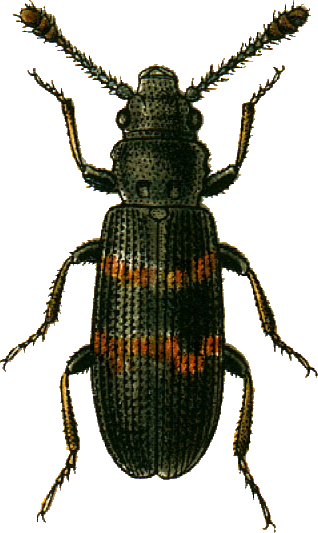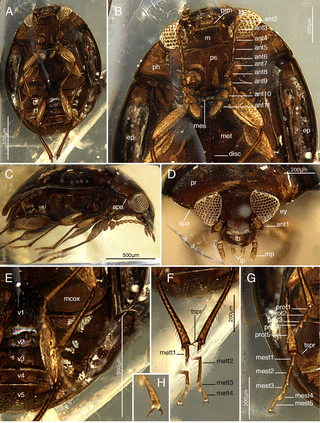
Polyphaga is the largest and most diverse suborder of beetles. It comprises 144 families in 16 superfamilies, and displays an enormous variety of specialization and adaptation, with over 350,000 described species, or approximately 90% of the beetle species discovered thus far.

Myxophaga is the second-smallest suborder of the Coleoptera after Archostemata, consisting of roughly 65 species of small to minute beetles in four families. The members of this suborder are aquatic and semiaquatic, and feed on algae.

Byrrhoidea is a superfamily of beetles belonging to Elateriformia that includes several families which are either aquatic or associated with a semi-aquatic habitat. Other than the superfamily Hydrophiloidea, most of the remaining Polyphagan beetles which are aquatic are in this superfamily.

Scirtoidea is a superfamily of beetles. It is traditionally considered to consist of four families: Clambidae, Decliniidae, Eucinetidae and Scirtidae. However, genetic studies have suggested that Clambidae and Eucinetidae belong to a separate superfamily Clamboidea, which also includes Derodontidae. Scirtoidea and Clamboidea are the two earliest diverging lineages of living polyphagans.

Nosodendridae is a family of beetles, with less than a hundred species in three extant genera, which are found worldwide. Nosodendron, the largest genus, is found in forests and attracted to yeast generated slime on the wounds of trees, and likely consumes fermented substances as well as fungi and microorganisms. Several additional genera and species are known from the fossil record. Nosodendridae is considered to be an isolated lineage within Polyphaga, being the sister group to the clade containing Staphyliniformia, Bostrichoidea and Cucujiformia.

The Ommatidae are a family of beetles in the suborder Archostemata. The Ommatidae are considered the extant beetle family that has most ancestral characteristics. There are only seven extant species, confined to Australia and South America. However, the geographical distribution was much wider during the Mesozoic spanning across Eurasia and Australia, suggesting that they were widespread on Pangea. So far, over 26 extinct genera containing over 170 species of these beetles have been described. Three extant genera have been assigned to this family: Omma,Tetraphalerus and Beutelius. The family is considered to be a subfamily of Cupedidae by some authors, but have been found to be more closely related to Micromalthidae in molecular phylogenies. A close relationship with Micromalthidae is supported by several morphological characters, including those of the mandibles and male genitalia. Due to their rarity, their ecology is obscure, it is likely that their larvae feed on deadwood.

Trogossitidae, also known as bark-gnawing beetles, are a small family in the superfamily Cleroidea. Many taxa formerly within this family have been removed to other families, such as Lophocateridae, Peltidae, Protopeltidae, Rentoniidae, and Thymalidae. Members of the family are generally predatory and/or feed on fungi, both in adult and larval stages, and are generally associated with wood, being found under bark or inside bored tunnel galleries. There are about 400 species in 25 genera in the family under the new, restricted circumscription, as opposed to 600 species in over 50 genera in the old definition. The oldest fossil assignable to the modern, more restricted definition of the family is Microtrogossita from the mid-Cretaceous Burmese amber of Myanmar, which has close affinities to the Trogossitini, indicating that the family had already considerably diversified by this time.

Boganiidae is a family of beetles, in the superfamily Cucujoidea. Members of the family are found in southern Africa, Australia and New Caledonia. Adults and larvae are pollenivorous, feeding on the pollen of cycads and flowering plants of the families Myrtaceae, Meliaceae, Cunoniaceae and Elaeocarpaceae. Metacucujus and Paracucujus act as pollinators for cycads Encephalartos and Macrozamia respectively. This association with cycads goes back to at least the Mid-Cretaceous, with an extinct form being found with preserved cycad pollen in 99 million year old Burmese amber.

Silvanidae, "silvan flat bark beetles", is a family of beetles in the superfamily Cucujoidea, consisting of 68 described genera and about 500 described species. The family is represented on all continents except Antarctica, and is most diverse at both the generic and species levels in the Old World tropics.

Phloeostichidae is a family of beetles in the superfamily Cucujoidea. They are typically found under the bark of dead trees. Larvae have been found to consume plant tissue and some fungi, while the adults appear to be exclusively fungivores. The family contains four extant genera, Phloeostichus is native to the Palearctic, Rhopalobrachium is native to central-southern South America and eastern Australia, Hymaea is native to southeastern Australia, and Bunyastichus is found in Tasmania.

The Brachypsectridae are a family of beetles commonly known as the Texas beetles. There are only two extant genera, Brachypsectra and Asiopsectra. Brachypsectra has a cosmopolitan distribution, mostly in arid regions, while Asiopsectra is found in Central Asia and the Middle East.

Rhinorhipus is a genus of beetles that contains a single species, Rhinorhipus tamborinensis from southern Queensland, Australia. It is the sole member of the family Rhinorhipidae and superfamily Rhinorhipoidea. It is an isolated lineage not closely related to any other living beetle, estimated to have split from other beetles at least 200 million years ago, with studies either considering them the earliest diverging member of Elateriformia, or a basal lineage within Polyphaga. They exhibit feigning death (thanatosis) when disturbed. Their ecology is poorly known. It is likely that they are fossorial based on their morphology.

Clambidae is a family of beetles. They are known commonly as the minute beetles or the fringe-winged beetles. They are found worldwide on every continent except Antarctica.

Artematopodidae is a family of soft-bodied plant beetles in the superfamily Elateroidea. They are mostly found in understory forest foliage. The life history of the group is obscure, larvae of the genera Eurypogon and Macropogon likely feed on moss, while the larvae of Artematopus have been fed insect remains. The oldest fossils of the family date to the Middle Jurassic.
Derolathrus is a genus of Jacobson's beetles in the family Jacobsoniidae. There are 11 described species in Derolathrus.

Cyclaxyridae are a family of beetles in the superfamily Cucujoidea. The only living genus is Cyclaxyra, with two species endemic to New Zealand. Other species have been named from fossils. They are also known as sooty mould beetles due to the association of Cyclaxyra with sooty mould. The extant species are mycophagous, feeding on spores, conidia, and hyphae.
2017 in paleoentomology is a list of new fossil insect taxa that were described during the year 2017, as well as other significant discoveries and events related to paleoentomology that were scheduled to occur during the year.
Echinocups is an extinct genus of ommatid beetle. It was created in 2020 to house three species originally assigned to Notocupes, E. denticollis, E. neli and E. ohmkuhnlei The genus name refers to the sharp spikes present on the elytra. All three species are known from the Cenomanian aged Burmese amber of Myanmar. The status of Echinocups as a distinct genus was contested by Li et al. (2023), who considered the genus Echinocups to be a junior synonym of the genus Notocupes.
Acalyptomerus asiaticus, is a species of fringe-winged beetle found in India, Sri Lanka, Malaysia and Thailand. It is also introduced to Jamaica.
Charentese amber is a type of amber that is found in sediments in the Charente-Maritime area of France. It dates to the late Albian to early Cenomanian stages of the mid-Cretaceous, around 100 million years ago. Charentese amber has been known since the early 19th century and was originally referred to as succin, succinic resin, or retinasphalt. The amber is known for its high quality and preservation of inclusions, such as insects, plant debris and other organisms. It is a valuable resource for paleontologists and other scientists studying the biodiversity of ancient ecosystems. The amber is often, but not always, opaque, requiring the usage of X-ray microtomography in order to observe specimens.
















